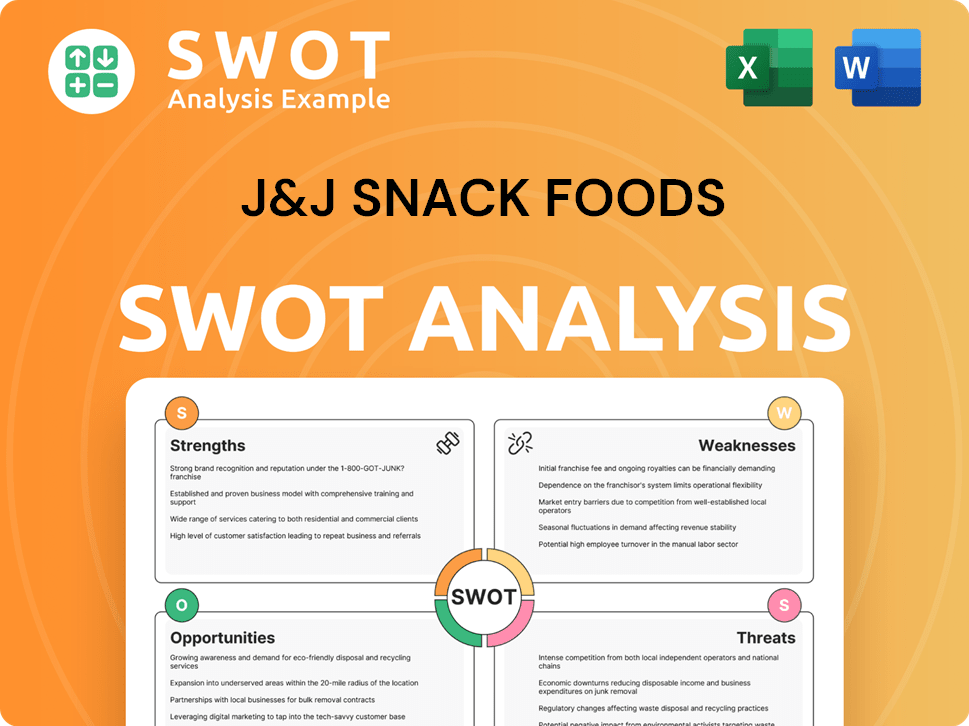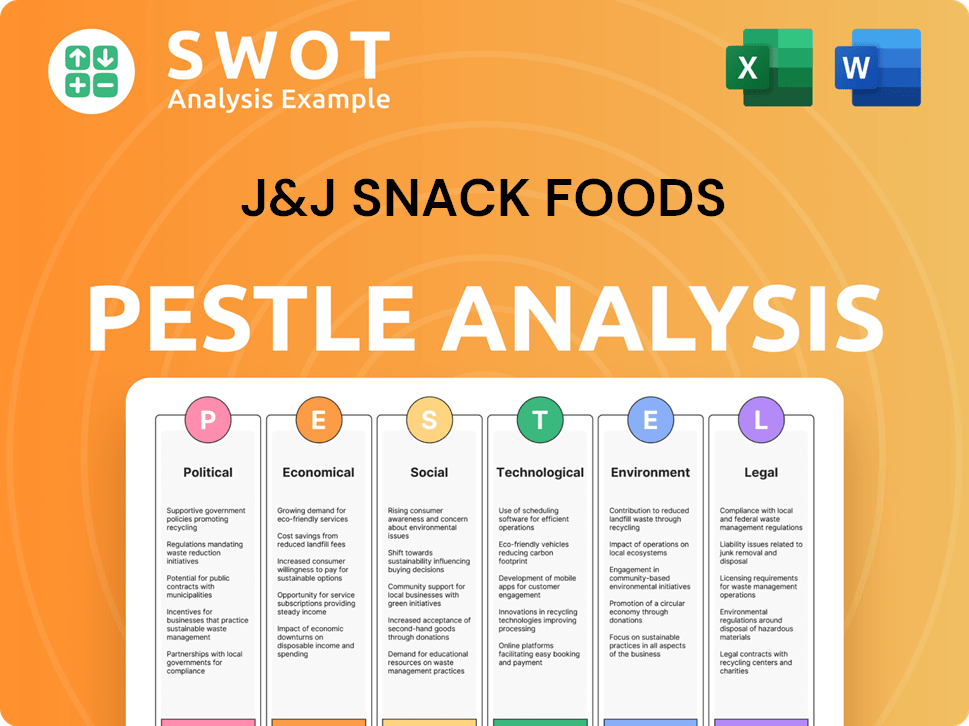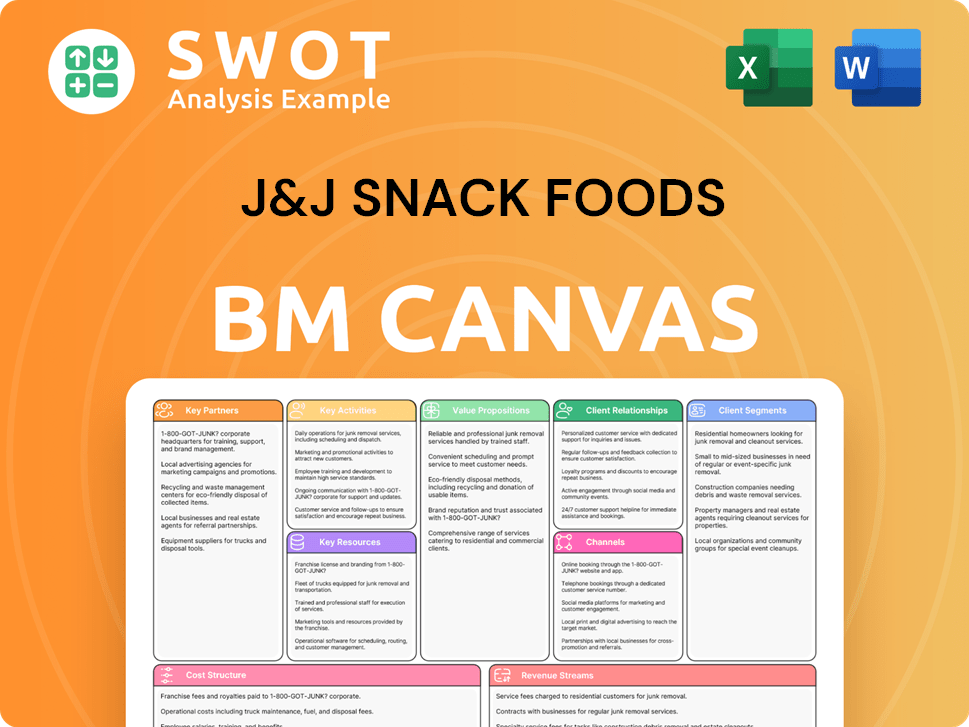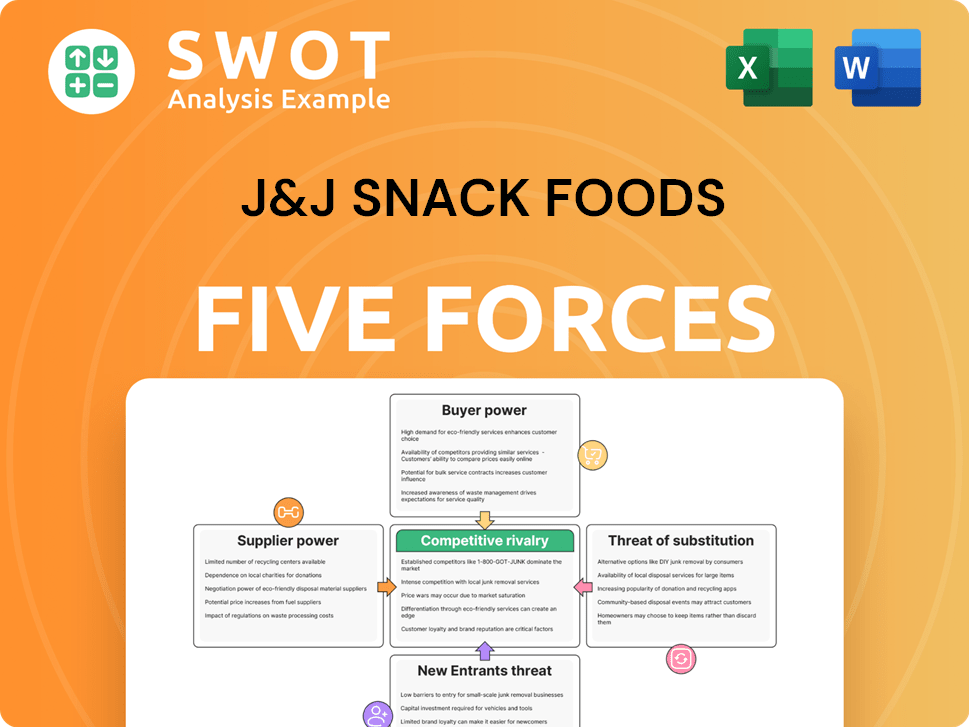J&J Snack Foods Bundle
Can J&J Snack Foods Conquer the Competitive Snack Food Arena?
In a market hungry for innovation and convenience, J&J Snack Foods Corp. navigates a complex landscape. From its humble beginnings, the company has evolved into a key player, offering a diverse portfolio of branded snacks and frozen beverages. Understanding its position within the J&J Snack Foods SWOT Analysis is crucial to grasping its strategic moves.

This exploration of the J&J Snack Foods competitive landscape will reveal its key rivals and J&J Snack Foods competitors, providing a detailed J&J Snack Foods market analysis. We'll dissect its competitive advantages and the industry trends shaping its future, offering insights into how it maintains its edge in the snack food industry against other food and beverage companies. This competitive analysis will equip you with the knowledge to evaluate J&J Snack Foods' potential.
Where Does J&J Snack Foods’ Stand in the Current Market?
J&J Snack Foods Corp. maintains a robust market position, particularly within the snack food and frozen beverage sectors. The company demonstrates a strong presence in niche markets. For a detailed look at their strategic growth, consider reading about the Growth Strategy of J&J Snack Foods.
The company's success is rooted in its diverse product lines, including soft pretzels, frozen beverages, handhelds, and bakery goods. These products cater to both foodservice and retail channels. Geographically, J&J Snack Foods has a strong presence across North America, serving a wide array of clients from schools and hospitals to supermarkets and entertainment complexes.
Financially, J&J Snack Foods shows a healthy scale, especially when compared to many niche snack food companies. For the fiscal year ending December 30, 2023, the company reported net sales of approximately $1.46 billion, reflecting a 9% increase from the prior year. This financial performance indicates sustained growth and a solid operational foundation.
J&J Snack Foods holds a dominant position in specific categories. For example, SUPERPRETZEL is a leading brand in the frozen soft pretzel category across retail and foodservice channels. The company also has a significant share in the frozen beverage market through its ICEE brand.
The company's primary market is North America, serving a wide range of clients. This includes schools, hospitals, supermarkets, and entertainment venues. This broad reach supports its market position.
In fiscal year 2023, net sales reached approximately $1.46 billion, a 9% increase. This growth reflects the company's ability to maintain and expand its market presence. The focus on efficiency and brand strength contributes to its stable financial health.
J&J Snack Foods has strategically expanded beyond its core foodservice roots. The company is increasingly focusing on retail channels to reach individual consumers directly. This diversification helps mitigate risks and tap into broader consumer trends.
J&J Snack Foods' strengths include brand recognition, a strong distribution network, and a focus on niche markets. These factors contribute to its competitive advantages in the snack food industry. The company's ability to adapt to changing consumer preferences and expand its product offerings is also a key strength.
- Dominant market share in soft pretzels and frozen beverages.
- Strong presence in both foodservice and retail channels.
- Consistent financial growth and a solid operational foundation.
- Strategic diversification into retail markets.
J&J Snack Foods SWOT Analysis
- Complete SWOT Breakdown
- Fully Customizable
- Editable in Excel & Word
- Professional Formatting
- Investor-Ready Format

Who Are the Main Competitors Challenging J&J Snack Foods?
The competitive landscape for J&J Snack Foods is multifaceted, encompassing a variety of players across its diverse product lines and distribution channels. A thorough J&J Snack Foods competitive landscape analysis reveals a dynamic environment where both direct and indirect competitors vie for market share. Understanding these competitive pressures is crucial for assessing the company's strategic positioning and future prospects.
The company's success hinges on its ability to navigate this complex environment, which includes adapting to changing consumer preferences, managing supply chain challenges, and responding to the strategies of its rivals. The snack food industry is subject to rapid change, with new products and distribution models constantly emerging. This requires continuous innovation and strategic agility to maintain a competitive edge.
In the soft pretzel market, the company faces competition from smaller regional pretzel manufacturers. While the company holds a strong position, these smaller players can offer localized products or compete on price. This competition necessitates a focus on product differentiation and efficient operations to maintain profitability.
Direct competitors include regional pretzel manufacturers and in-store bakeries within grocery chains. These competitors often focus on localized products and competitive pricing strategies.
In the frozen beverage sector, the company competes with other dispensed beverage systems and ready-to-drink frozen beverages. Major players include Coca-Cola and PepsiCo, which have extensive distribution networks.
The handhelds and bakery goods segment faces competition from large food manufacturers like Conagra Brands and General Mills. Private label brands from major supermarkets also pose a significant challenge.
Emerging players in the broader snack food industry, particularly those focused on health-conscious or plant-based snacks, could indirectly impact the company. Mergers and acquisitions within the food industry constantly reshape the competitive dynamics.
The company's market share is subject to fluctuations based on competitive actions, consumer preferences, and economic conditions. Maintaining and growing market share requires strategic initiatives and effective execution.
Competition also exists within distribution channels, with companies vying for shelf space and consumer attention. Effective distribution strategies are crucial for reaching target markets and maximizing sales.
In the frozen beverage sector, the company's ICEE brand competes with other dispensed beverage systems and ready-to-drink frozen beverages. Major players in this space include Coca-Cola and PepsiCo, which offer their own frozen beverage lines and have extensive distribution networks. For handhelds and bakery goods, the competitive landscape is even broader, including large food and beverage companies like Conagra Brands and General Mills. These companies often have significantly larger scales, broader product portfolios, and more extensive marketing budgets. Additionally, private label brands from major supermarkets pose a significant challenge, offering similar products at lower price points. Emerging players in the broader snack food industry, particularly those focused on health-conscious or plant-based snacks, could also indirectly impact the company by shifting consumer preferences. For more insights, consider reading about the Growth Strategy of J&J Snack Foods.
Several factors influence the company's competitive position, including product innovation, brand recognition, distribution capabilities, and pricing strategies. Understanding these factors is essential for a comprehensive competitive analysis.
- Product Innovation: The ability to introduce new and appealing products is crucial for staying ahead of competitors.
- Brand Recognition: Strong brand recognition helps build customer loyalty and market share.
- Distribution Capabilities: Efficient distribution networks ensure products reach consumers effectively.
- Pricing Strategies: Competitive pricing is necessary to attract customers and maintain profitability.
J&J Snack Foods PESTLE Analysis
- Covers All 6 PESTLE Categories
- No Research Needed – Save Hours of Work
- Built by Experts, Trusted by Consultants
- Instant Download, Ready to Use
- 100% Editable, Fully Customizable

What Gives J&J Snack Foods a Competitive Edge Over Its Rivals?
Understanding the J&J Snack Foods competitive landscape involves recognizing its distinct advantages. The company, a prominent player in the snack food industry, has cultivated strong brand recognition and a robust distribution network. This has allowed it to establish a solid market position and maintain a competitive edge against rivals. A detailed J&J Snack Foods market analysis reveals the strategies that have contributed to its success.
J&J Snack Foods, like other food and beverage companies, faces challenges and opportunities within its industry. Its ability to navigate these dynamics is crucial for sustained growth. The company's focus on niche categories, such as soft pretzels and frozen beverages, allows it to specialize and optimize its operations. This specialization is a key component of its competitive strategy.
Examining the competitive analysis of J&J Snack Foods highlights its strengths. These include brand equity, a broad distribution network, and operational efficiency. These advantages enable the company to maintain a strong presence in its target markets. For further insights into the company's ownership structure, you can explore Owners & Shareholders of J&J Snack Foods.
J&J Snack Foods benefits from strong brand equity, particularly with SUPERPRETZEL and ICEE. These brands are widely recognized and foster significant customer loyalty. This recognition allows for premium pricing and consistent demand across various channels.
The company boasts a robust distribution network, spanning both foodservice and retail sectors. This dual-channel approach enables J&J Snack Foods to reach a broad customer base. Established relationships with distributors and retailers provide a significant barrier to entry for new competitors.
J&J Snack Foods achieves economies of scale in production and procurement. This allows for efficient high-volume production and effective cost management. Operational efficiency is crucial in a price-sensitive market, enhancing its competitive position.
Focusing on niche snack categories, such as soft pretzels and frozen dispensed beverages, gives the company a competitive edge. This specialization allows for deep expertise and optimized production processes. Ongoing product innovation helps maintain consumer interest and market leadership.
J&J Snack Foods leverages several competitive advantages to maintain its market position. These advantages include strong brand recognition, an extensive distribution network, and operational efficiencies. The company's strategic focus on niche markets also contributes to its success.
- Strong Brand Equity: Brands like SUPERPRETZEL and ICEE drive customer loyalty.
- Robust Distribution: A broad network reaches both foodservice and retail sectors.
- Operational Efficiency: Economies of scale lead to effective cost management.
- Niche Market Focus: Specialization in soft pretzels and frozen beverages.
J&J Snack Foods Business Model Canvas
- Complete 9-Block Business Model Canvas
- Effortlessly Communicate Your Business Strategy
- Investor-Ready BMC Format
- 100% Editable and Customizable
- Clear and Structured Layout

What Industry Trends Are Reshaping J&J Snack Foods’s Competitive Landscape?
The competitive landscape for J&J Snack Foods is dynamic, shaped by evolving consumer preferences and market dynamics. The company navigates a sector characterized by both established players and emerging trends. Understanding the J&J Snack Foods competitive landscape involves analyzing its position within the snack food industry, identifying its primary rivals, and assessing its strategic responses to market challenges and opportunities.
Risks include shifts in consumer behavior, ingredient cost volatility, and the impact of economic conditions on purchasing power. The future outlook for J&J Snack Foods depends on its ability to adapt to these changes, innovate its product offerings, and maintain a strong market presence. A thorough J&J Snack Foods market analysis is essential for evaluating its long-term prospects.
The snack food industry is witnessing a surge in demand for convenient, on-the-go snack options. Consumers are increasingly seeking healthier alternatives, leading to a focus on transparency in ingredients. Technological advancements in food processing and supply chain management are also influencing the sector. These trends impact how food and beverage companies like J&J Snack Foods operate and innovate.
Regulatory changes, particularly those related to food labeling and nutritional guidelines, pose challenges. Global economic shifts, including inflation, can affect raw material costs and consumer spending. The rise of direct-to-consumer models and e-commerce also necessitates adjustments in distribution strategies. These factors require ongoing strategic adaptation for companies in the competitive analysis.
Significant growth opportunities exist in emerging markets, where demand for branded snack foods is increasing. Product innovations, such as plant-based versions of popular snacks, can unlock new revenue streams. Strategic partnerships can also enhance distribution and introduce new product concepts. These opportunities offer avenues for sustained growth and market expansion.
J&J Snack Foods is likely to focus on brand strength, operational efficiency, and targeted product innovation. This approach helps capitalize on opportunities and mitigate future challenges. A strong brand and efficient operations are crucial for maintaining a competitive edge. You can gain more insights by reading about Marketing Strategy of J&J Snack Foods.
To maintain a competitive edge, J&J Snack Foods must navigate several factors. This includes adapting to changing consumer preferences and managing operational costs. The company's ability to innovate and respond to market dynamics will be crucial.
- Market Share Analysis: Understanding the company's position relative to its competitors.
- Product Portfolio Analysis: Assessing the diversity and appeal of J&J's product offerings.
- Geographical Market Analysis: Examining the company's presence and performance in different regions.
- Financial Performance: Comparing revenue and profitability with those of competitors.
J&J Snack Foods Porter's Five Forces Analysis
- Covers All 5 Competitive Forces in Detail
- Structured for Consultants, Students, and Founders
- 100% Editable in Microsoft Word & Excel
- Instant Digital Download – Use Immediately
- Compatible with Mac & PC – Fully Unlocked

Related Blogs
- What are Mission Vision & Core Values of J&J Snack Foods Company?
- What is Growth Strategy and Future Prospects of J&J Snack Foods Company?
- How Does J&J Snack Foods Company Work?
- What is Sales and Marketing Strategy of J&J Snack Foods Company?
- What is Brief History of J&J Snack Foods Company?
- Who Owns J&J Snack Foods Company?
- What is Customer Demographics and Target Market of J&J Snack Foods Company?
Disclaimer
All information, articles, and product details provided on this website are for general informational and educational purposes only. We do not claim any ownership over, nor do we intend to infringe upon, any trademarks, copyrights, logos, brand names, or other intellectual property mentioned or depicted on this site. Such intellectual property remains the property of its respective owners, and any references here are made solely for identification or informational purposes, without implying any affiliation, endorsement, or partnership.
We make no representations or warranties, express or implied, regarding the accuracy, completeness, or suitability of any content or products presented. Nothing on this website should be construed as legal, tax, investment, financial, medical, or other professional advice. In addition, no part of this site—including articles or product references—constitutes a solicitation, recommendation, endorsement, advertisement, or offer to buy or sell any securities, franchises, or other financial instruments, particularly in jurisdictions where such activity would be unlawful.
All content is of a general nature and may not address the specific circumstances of any individual or entity. It is not a substitute for professional advice or services. Any actions you take based on the information provided here are strictly at your own risk. You accept full responsibility for any decisions or outcomes arising from your use of this website and agree to release us from any liability in connection with your use of, or reliance upon, the content or products found herein.